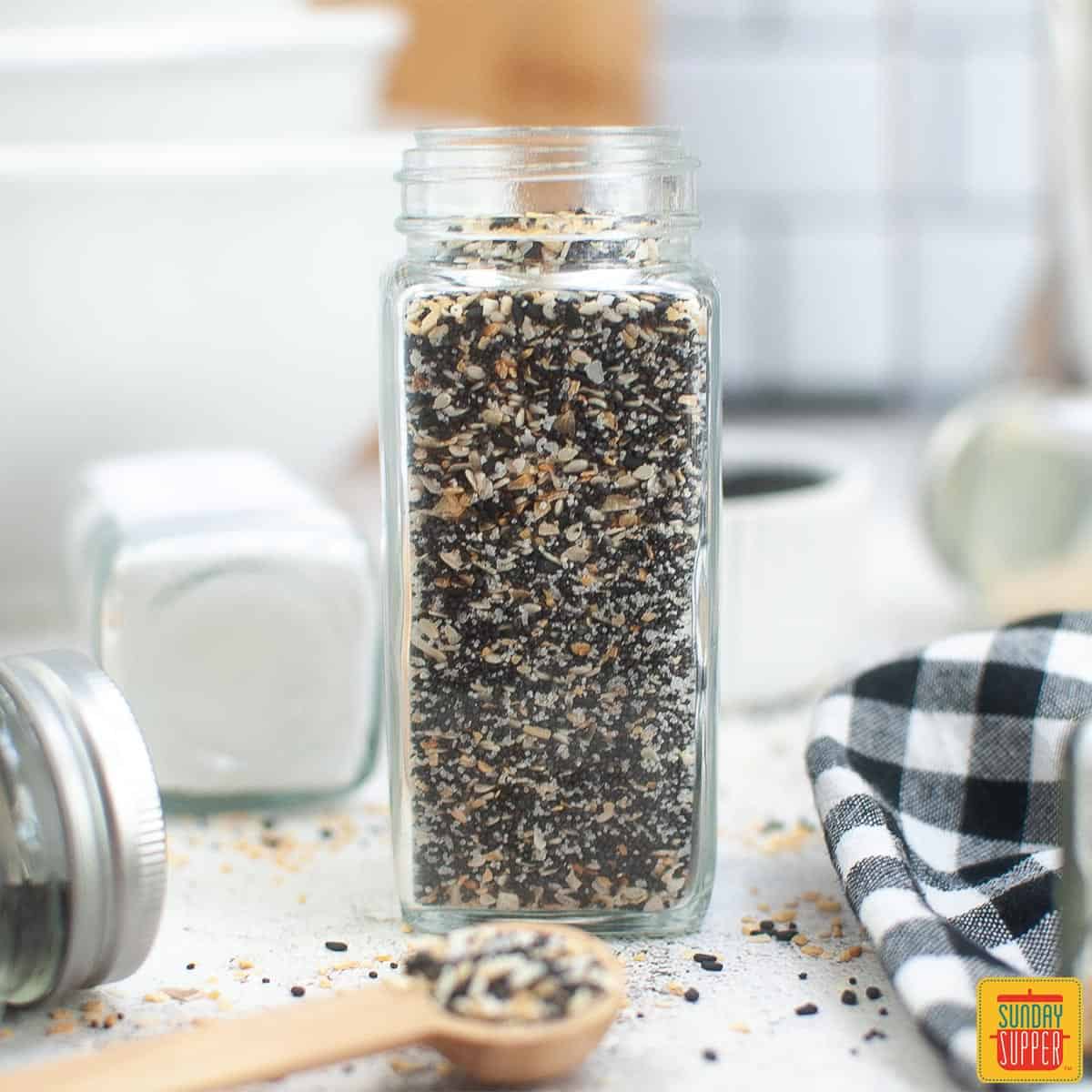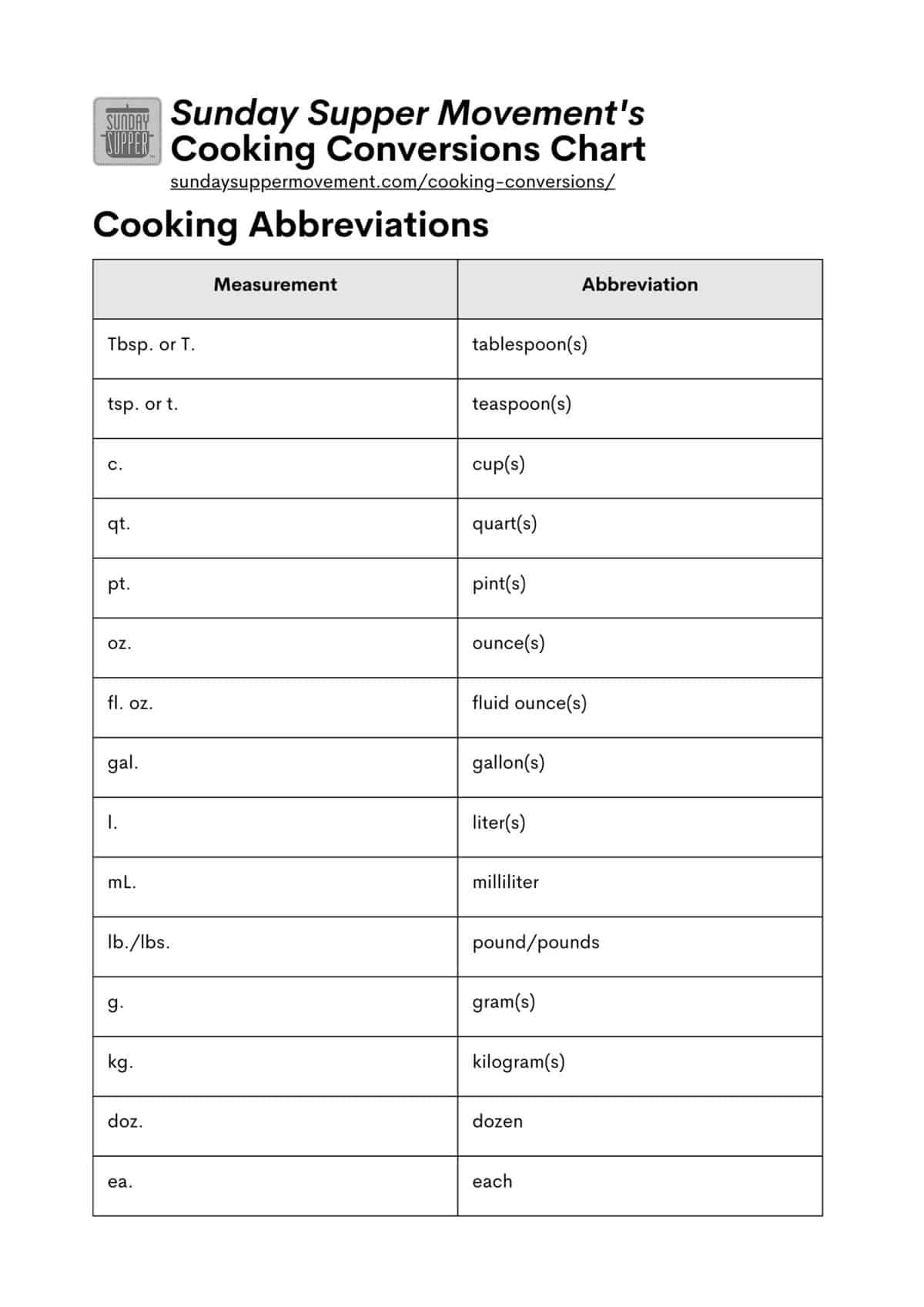This post may contain paid links. See more info on my privacy page.
Following this easy Cooking Measurements and Conversions chart, you won't have to second-guess any recipes! Learn how to simply convert everything from teaspoons to Tablespoons, to common cooking abbreviations. Read on for a free printable chart!

Jump to:
- Measurements for Cooking
- Measuring Tools for Cooking
- Cooking Abbreviations
- Teaspoons to Tablespoons
- Teaspoons and Tablespoons to Dessertspoons
- What does 1 cup equal?
- Tablespoons to Cups
- Cups to Grams
- Cups to Dry Ounces
- Cups to Fluid Ounces
- Measuring Butter
- Baking Measurements
- Oven Temperature Conversions
- Printable Kitchen Measurements Chart
- Cooking Conversions FAQs
- Tips for Measuring Ingredients
- Cooking Guides
- Reviews
Measurements for Cooking
When I first started cooking, I'll admit, I had no idea how to convert one measurement to another. I would spend extra time I could have spent actually cooking instead looking up how many teaspoons are in a tablespoon, or how many tablespoons of butter equals a cup.
It took me years of necessity to learn how to make these conversions without having to open a cookbook or pull up a search engine every time I wanted answers. I want it to be easy for you, too - that's why I put together this cooking measurements chart!
This guide has all the abbreviations for cooking measurements, plus cooking measurement conversion, you need not only to get started but for more advanced recipes, too. Whether you're a novice or have been cooking all your life, I'm certain it will be useful for you. I've even included basic oven temperature conversions!
Best of all, you can find a free printable at the bottom of the page. Print it out, put it on the side of your fridge, and use it as you need it. You'll never question yourself again!
Measuring Tools for Cooking
- Kitchen scale
- Measuring spoons
- Measuring cups - for dry and liquid ingredients
- Instant Read Meat Thermometer - you should always have one of these for meat to measure internal temperature!
Cooking Abbreviations
| Measurement | Abbreviation |
|---|---|
| Tbsp. or T. | tablespoon(s) |
| tsp. or t. | teaspoon(s) |
| c. | cup(s) |
| qt. | quart(s) |
| pt. | pint(s) |
| oz. | ounce(s) |
| fl. oz. | fluid ounce(s) |
| gal. | gallon(s) |
| l. | liter(s) |
| mL. | milliliter |
| lb./lbs. | pound/pounds |
| g. | gram(s) |
| kg. | kilogram(s) |
| doz. | dozen |
| ea. | each |
Above are the common cooking abbreviations for measurements used by most recipes. Keeping this chart handy will make it easier to convert cooking measurements from metric to U.S., or vise-versa.
Teaspoons to Tablespoons
| Teaspoons | Tablespoons |
|---|---|
| 1½ tsp. | ½ Tbsp. |
| 3 tsp. | 1 Tbsp. |
| 4½ tsp. | 1½ Tbsp. |
| 6 tsp. | 2 Tbsp. |
| 7½ tsp. | 2½ Tbsp. |
| 9 tsp. | 3 Tbsp. |
| 10½ tsp. | 3½ Tbsp. |
There are 3 teaspoons to every 1 Tablespoon. Follow this cooking conversions chart, which includes half-measurements, for easy conversion from teaspoons to Tablespoons.
Teaspoons and Tablespoons to Dessertspoons
| Dessertspoons | Teaspoons | Tablespoons | Milliliters |
|---|---|---|---|
| ½ dstspn. | 1 tsp. | ⅓ Tbsp. | 5 mL. |
| 1 dstspn. | 2 tsp. | ⅔ Tbsp. | 10 mL. |
| 1½ dstspn. | 3 tsp. | 1 Tbsp. | 15 mL. |
| 2 dstspn. | 4 tsp. | 1⅓ Tbsp. | 20 mL. |
| 2½ dstspn. | 5 tsp. | 2 Tbsp. | 25 mL. |
A dessertspoon is a unit of measurement used in the UK, and is typically abbreviated as "dsp" or "dstspn". You can convert dessertspoons to Tablespoons, teaspoons, or millileters easily following this chart.
What does 1 cup equal?
| Measurement | Equal to 1 Cup |
|---|---|
| Fluid Ounces | 8 fl. oz. |
| Teaspoons | 48 tsp. |
| Tablespoons | 16 Tbsp. |
| Milliliters | 240 mL. |
| Pints | ½ pt. |
| Quarts | ¼ qt. |
| Gallons | 1 sixteenth of 1 gal. |
Tablespoons to Cups
| Tablespoons | Cups |
|---|---|
| 2 Tbsp. | ⅛ c. |
| 4 Tbsp. | ¼ c. |
| 5 Tbsp. + 1 tsp. | ⅓ c. |
| 8 Tbsp. | ½ c. |
| 12 Tbsp. | ¾ c. |
| 16 Tbsp. | 1 c. |
| 24 Tbsp. | 1½ c. |
There are 16 Tablespoons to every 1 cup. This cooking conversions chart allows for easy conversion from Tablespoons to cups.
Cups to Grams
| Cups | Grams |
|---|---|
| ⅛ c. | 16 g. |
| ¼ c. | 32 g. |
| ⅓ c. | 43 g. |
| ½ c. | 64 g. |
| ⅔ c. | 85 g. |
| ¾ c. | 96 g. |
| 1 c. | 128 g. |
| 1½ c. | 192 g. |
| 2 c. | 256 g. |
Every 1 cup is about 128 grams for measuring dry ingredients such as flour. Use a kitchen scale for best results when measuring cups to grams.
Cups to Dry Ounces
| Cups | Ounces |
|---|---|
| ⅛ c. | 0.563 oz. |
| ¼ c. | 1.13 oz. |
| ⅓ c. | 1.5 oz. |
| ½ c. | 2.25 oz. |
| ⅔ c. | 3 oz. |
| ¾ c. | 3.38 oz. |
| 1 c. | 4.5 oz. |
| 1½ c. | 6.75 oz. |
| 2 c. | 9 oz. |
Follow the above chart to convert dry ingredients, not including bread flour, from cups to ounces. If you're baking, make sure to use a kitchen scale to measure your ingredients accurately.
Cups to Fluid Ounces
| Cups | Ounces |
|---|---|
| ⅛ c. | 1 fl. oz. |
| ¼ c. | 2 fl. oz. |
| ⅓ c. | 2.66 fl. oz. |
| ½ c. | 4 fl. oz. |
| ⅔ c. | 5.28 fl. oz. |
| ¾ c. | 6 fl. oz. |
| 1 c. | 8 fl. oz. |
| 1½ c. | 12 fl. oz. |
| 2 c. | 16 fl. oz. |
There are about 8 fluid ounces to every 1 cup when measuring wet ingredients such as chicken stock.
Measuring Butter
| Tablespoons | Cups | Ounces |
|---|---|---|
| 2 Tbsp. | ⅛ c. | 1 fl. oz. |
| 4 Tbsp. | ¼ c. | 2 fl. oz. |
| 5 Tbsp. + 1 tsp. | ⅓ c. | 2.66 fl. oz. |
| 8 Tbsp. | ½ c. | 4 fl. oz. |
| 11 Tbsp. | ⅔ c. | 5.28 fl. oz. |
| 12 Tbsp. | ¾ c. | 6 fl. oz. |
| 16 Tbsp. | 1 c. | 8 fl. oz. |
| 24 Tbsp. | 1½ c. | 12 fl. oz. |
| 32 Tbsp. | 2 c. | 16 fl. oz. |
It's easier than it seems to convert sticks of butter to Tablespoons. Follow this chart for an easy way to measure how many Tablespoons, or cups, are in a stick of butter.
Baking Measurements
| Ingredient with Measurement | Ounces | Grams |
|---|---|---|
| 1 c. All-purpose flour | 4.25 oz. | 120 g. |
| 1 c. Bread flour | 4.8 oz. | 136 g. |
| 1 c. White sugar | 7 oz. | 198 g. |
| 1 c. Powdered sugar/Confectioner's sugar (unsifted) | 4 oz. | 113.5 g. |
| 1 c. Brown sugar (light or dark, packed) | 7.5 oz. | 213 g. |
| 1 c. Oats (old-fashioned/instant) | 3.125 oz. | 89 g. |
| 1 tsp. Baking powder | - | 4 g. |
| 1 tsp. Baking soda | - | 5 g. |
| 1 c. Cornstarch | 4 oz. | 112 g. |
| 1 c. Chocolate (chips, chunks, or chopped) | 6 oz. | 170 g. |
| 1 large egg | 1.75 oz. | 50 g. |
| 1 c. Milk | 8 oz. | 227 g. |
| 1 c. Heavy Cream | 8.4 oz. | 238 g. |
For common baking measurements, follow this easy cooking measurement chart, which includes common ingredients you can find in most baking recipes.
Oven Temperature Conversions
| Fahrenheit | Celsius |
|---|---|
| 200°F | 93°C |
| 225°F | 107°C |
| 250°F | 121°C |
| 275°F | 135°C |
| 300°F | 149°C |
| 325°F | 163°C |
| 350°F | 177°C |
| 375°F | 191°C |
| 400°F | 204°C |
| 425°F | 218°C |
| 450°F | 232°C |
| 475°F | 246°C |
Printable Kitchen Measurements Chart
For a free, printer-friendly version of all of the kitchen measurements and cooking abbreviations found above, click here: Kitchen Measurements Chart

Cooking Conversions FAQs
The best way to remember cooking conversions is to keep a chart handy while you're cooking. You can print the charts and keep them in a folder in your kitchen, or hang them up on your refrigerator or inside cabinet doors to easily reference. I like to keep mine near my measuring spoons and cups so they're always in easy reach.
In basic cooking recipes, you won't strictly need a kitchen scale to measure your ingredients. However, in baking recipes, exact measurements are important. For baking, always use a kitchen scale and measure your ingredients precisely for good results.
The metric system is thought to be the easiest measuring system to use for conversions because all numbers using this system are multiplied or divided by powers of 10. For example, 1000 milliliters is equal to 1 liter. However, the U.S. measurement system is common with recipes online, so it's handy to have a cooking measurements chart to help with quick conversions.
Tips for Measuring Ingredients
- The "spoon and level" method should be used when measuring dry ingredients for baking, such as flour. This ensures exact measurements, and it's easy!
- Stir the flour in its container with a spoon (I like to store my flour in an airtight jar rather than a bag).
- Gradually spoon the flour into your measuring cup.
- Fill the cup to overflowing with flour.
- Level the top using the back of a knife to get rid of the excess flour.
- Own a proper set of measuring cups, liquid measuring cups, measuring spoons, and a kitchen scale. See: Measuring Tools
Have any questions? Looking for help with measurements for a specific recipe? We're happy to answer them for you! Comment with your questions below.
Cooking Guides
- Sign up for our Newsletter for easy recipes every week to help get started cooking!
- See my guide on Seasoning with Salt for tips on what types of salt to use and when!
- Chicken Temperature Chart
- Turkey Temperature
- How to Clean a Dutch Oven



Pat Gibson says
I used to make a stuffed eggplant by cutting it in half lengthwise. I hollowed out the centers of each side and reserved the parts. I mixed those insides with other ingredients and stuffed the halves with the mixture. It's been a long time since I did one and I can't remember all the other ingredients I put into the stuffing. It was so good after baking it. Any ideas on what other ingredients I might use in the stuffing?
Isabel Laessig says
Hi Pat! I love stuffed eggplant. I actually have a stuffed eggplant recipe you can try - here's the link: Stuffed Eggplant Recipe. You could also stuff eggplant with any ground meat you like, and I would recommend Mediterranean or Italian style seasoning and ingredients. Rice, tomatoes, etc. You could also try stuffing eggplant with my holiday sage sausage stuffing (link) and I imagine it would be delicious. Enjoy!